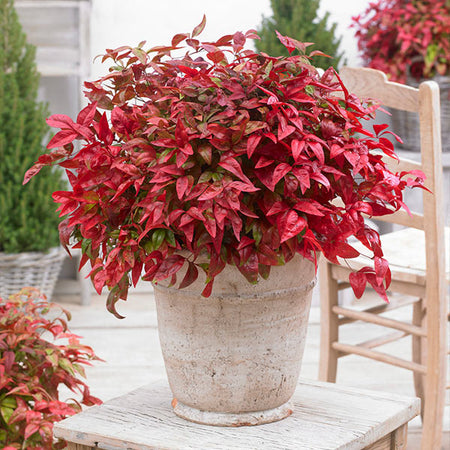Nandina Shrubs
Showing 1 - 5 of 5 items
Starting at $26.99
Growing Zones: 6-10
Sold Out
Growing Zones: 6-10
Starting at $91.99
Growing Zones: 6-10
Sold Out
Growing Zones: 6-9
Sold Out
Growing Zones: 6-10
The Complete Guide to Nandina Shrubs
Nandinas are colorful shrubs that are easy to grow and maintain. The hardy plants typically have no pest or disease problems and reward gardeners with year-round color. And our Nandinas pack some color punch!
Nandinas are known for their fall foliage, which can take on brilliant red colors and hold much of the color through winter, making them the perfect holiday plant in the landscape. Nandinas love sun, but can handle temperature ranges in zones 6 through 10. Nandinas are the perfect landscape plant for beginners or experienced gardeners.
The Top Nandina Shrub Varieties
Heavenly Bamboo Nandina A virtual rainbow of red-tinted colors in one sun-loving shrub that is semi- evergreen.
Fire Power Nandina This is a compact shrub of contrasts. Fern-like leaves turn fiery red in the fall, but bright white blooms appear in spring.
Harbor Belle Nandina A compact Nandina that grows to only 2 feet in height, with evergreen foliage, tiny white flowers in spring and red berries in fall. It requires no pruning.
How and Where To Plant Nandina Shrubs
Nandinas grow in nearly any sun or soil conditions, but perform best in well-draining soil. And although the plant can survive with shade, you'll get the most color from the foliage if your shrub receives full sun. Nandinas are hardy, and the leaves typically remain on the plants in milder winters. If lows reach 10 degrees Fahrenheit, the shrub's leaves will drop. A few degrees colder might damage the stems, although the plant usually recovers.
All of these soil, sun and temperature considerations can help you choose the best spot for Nandina in your landscape. If your nighttime temperatures tend to drop close to 10 degrees, place your Nandina against a south-facing wall, so the wall or house can help warm the plant. Otherwise, simply give your shrub as much sun as possible and watch it flourish. Nandinas are a favorite hedge shrub and should be placed about 2 to 3 feet apart to allow for mature plant size. If you have a berry-producing type of Nandina, it is more likely to produce fruit if placed in a hedge or other group planting than as a single shrub in your garden. Purchasing larger plants leads to having the finished hedge look sooner.
Planting your Nandina is easy. Make sure you place the plant in well-draining soil in a hole about two times larger than the size of the pot it's in. Nandinas grow better if you add a thin layer of organic mulch after planting and filling the hole. Then water well, at least once a week during hotter weeks until the plants are established.
Caring for Nandina Shrubs
Once Nandinas are established, they need only weekly watering or less, depending on weather. One of the few problems a gardener can have with Nandina is iron chlorosis from overwatering. When this happens, you'll notice that the shrub's leaves begin to yellow. If you're watering the shrub during spring rains, try turning off your automatic irrigation to correct the problem.
Nandinas can be transplanted any time of year in most zones except in the middle of the summer. Water the shrubs a little more than normal after moving or planting them. The only regular maintenance required is to ensure that the plant continues to have fertile soil and to prune for shape and renewal early in the spring or late in winter before its growth period. Cut no more than a third of older stems down to the ground to keep the shrub's density.
Facts About Nandina Shrubs
Nandina often is called "Heavenly Bamboo." The plant first arrived in the early 1800s. Growers continue to develop new characteristics in Nandinas, such as the lime green leaves of Fire Power that slowly turn red for continuous change and interest.
Nandina is a versatile shrub, with compact varieties to serve as groundcovers or foreground foliage in your landscape and larger varieties that can grow to nearly 8 feet tall. They look great in an Asian garden, of course, or in a native landscape. Simply prune the shrub less than you would for a hedge planting and let the Nandina take its more natural shape. The plant is drought tolerant in many zones once established.







